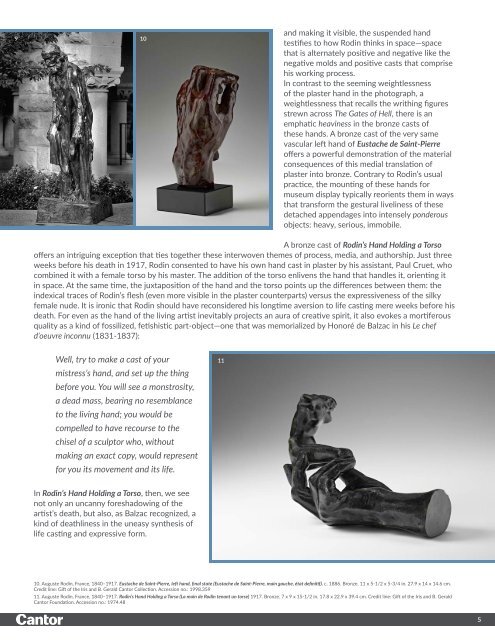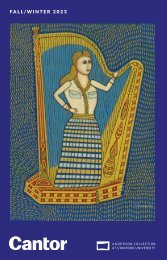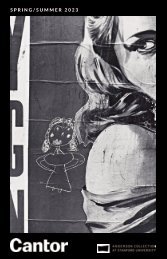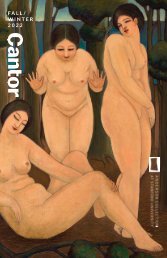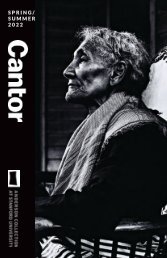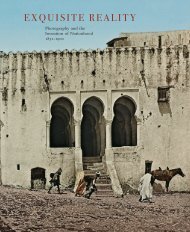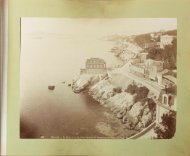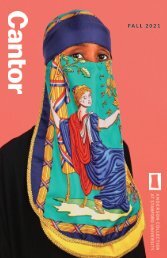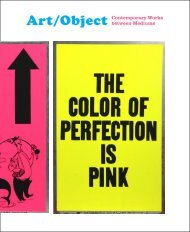Learning Guide | Recasting Rodin
It would hardly be an exaggeration to say that Auguste Rodin (1840–1917) forever changed the history of sculpture. Rarely had the medium so audaciously challenged the primacy of painting over the course of the nineteenth century. Long regarded as a “dead” medium of motionless, inert material, sculpture in Rodin’s nimble hands comes alive, breaking free of the plinths that traditionally separated sculpted figures in stone or metal from their earthbound beholders in flesh and blood. Patrick R. Crowley, PhD Associate Curator, European Art Cantor Arts Center
It would hardly be an exaggeration to say that Auguste Rodin (1840–1917) forever changed the history of sculpture. Rarely had the medium so audaciously challenged the primacy of painting over the course of the nineteenth century. Long regarded as a “dead” medium of motionless, inert material, sculpture in Rodin’s nimble hands comes alive, breaking free of the plinths that traditionally separated sculpted figures in stone or metal from their earthbound beholders in flesh and blood.
Patrick R. Crowley, PhD
Associate Curator, European Art
Cantor Arts Center
You also want an ePaper? Increase the reach of your titles
YUMPU automatically turns print PDFs into web optimized ePapers that Google loves.
9 10<br />
and making it visible, the suspended hand<br />
testifies to how <strong>Rodin</strong> thinks in space—space<br />
that is alternately positive and negative like the<br />
negative molds and positive casts that comprise<br />
his working process.<br />
In contrast to the seeming weightlessness<br />
of the plaster hand in the photograph, a<br />
weightlessness that recalls the writhing figures<br />
strewn across The Gates of Hell, there is an<br />
emphatic heaviness in the bronze casts of<br />
these hands. A bronze cast of the very same<br />
vascular left hand of Eustache de Saint-Pierre<br />
offers a powerful demonstration of the material<br />
consequences of this medial translation of<br />
plaster into bronze. Contrary to <strong>Rodin</strong>’s usual<br />
practice, the mounting of these hands for<br />
museum display typically reorients them in ways<br />
that transform the gestural liveliness of these<br />
detached appendages into intensely ponderous<br />
objects: heavy, serious, immobile.<br />
A bronze cast of <strong>Rodin</strong>’s Hand Holding a Torso<br />
offers an intriguing exception that ties together these interwoven themes of process, media, and authorship. Just three<br />
weeks before his death in 1917, <strong>Rodin</strong> consented to have his own hand cast in plaster by his assistant, Paul Cruet, who<br />
combined it with a female torso by his master. The addition of the torso enlivens the hand that handles it, orienting it<br />
in space. At the same time, the juxtaposition of the hand and the torso points up the differences between them: the<br />
indexical traces of <strong>Rodin</strong>’s flesh (even more visible in the plaster counterparts) versus the expressiveness of the silky<br />
female nude. It is ironic that <strong>Rodin</strong> should have reconsidered his longtime aversion to life casting mere weeks before his<br />
death. For even as the hand of the living artist inevitably projects an aura of creative spirit, it also evokes a mortiferous<br />
quality as a kind of fossilized, fetishistic part-object—one that was memorialized by Honoré de Balzac in his Le chef<br />
d’oeuvre inconnu (1831-1837):<br />
Well, try to make a cast of your<br />
mistress’s hand, and set up the thing<br />
before you. You will see a monstrosity,<br />
a dead mass, bearing no resemblance<br />
to the living hand; you would be<br />
compelled to have recourse to the<br />
chisel of a sculptor who, without<br />
making an exact copy, would represent<br />
for you its movement and its life.<br />
11<br />
In <strong>Rodin</strong>’s Hand Holding a Torso, then, we see<br />
not only an uncanny foreshadowing of the<br />
artist’s death, but also, as Balzac recognized, a<br />
kind of deathliness in the uneasy synthesis of<br />
life casting and expressive form.<br />
10. Auguste <strong>Rodin</strong>, France, 1840–1917. Eustache de Saint-Pierre, left hand, final state (Eustache de Saint-Pierre, main gauche, état definitif). c. 1886. Bronze. 11 x 5-1/2 x 5-3/4 in. 27.9 x 14 x 14.6 cm.<br />
Credit line: Gift of the Iris and B. Gerald Cantor Collection. Accession no.: 1998.359<br />
11. Auguste <strong>Rodin</strong>, France, 1840–1917. <strong>Rodin</strong>’s Hand Holding a Torso (La main de <strong>Rodin</strong> tenant un torse) 1917. Bronze. 7 x 9 x 15-1/2 in. 17.8 x 22.9 x 39.4 cm. Credit line: Gift of the Iris and B. Gerald<br />
Cantor Foundation. Accession no.: 1974.48<br />
5


